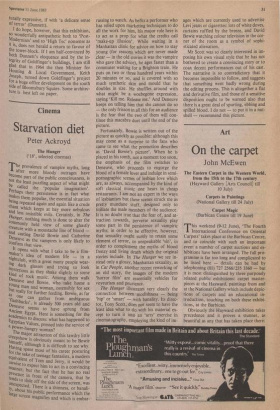Cinema
Starvation diet
Peter Ackroyd
The Hunger (`18', selected cinemas)
The prevalence of vampire myths, long after more bloody outrages have become part of the public consciousness, is not the least puzzling aspect of what might be called the 'popular imagination'. Perhaps their persistence is in fact what makes them popular, the essential situation being repeated again and again like a crude chant which keeps at bay more nebulous and less resistible evils. Certainly, in The Hunger, nothing much is done to alter the commonly held view of some ghastly creature with a moustache line of blood - and casting David Bowie and Catherine Deneuve as the vampires is only likely to confirm that view. It opens with what I take to be a film- maker's idea of modern life — in a nightclub, . ghtclub, with a great many people wear- ing dark glasses and trying to look mysterious is they shake slightly to some kind of rock music. Among them walk Deneuve and Bowie, who take home a Yung man and woman, ostensibly for sex but really for further feeding. Bowie, as far a, s one can gather from ambiguous flashbacks', is already 300 years old and Deneuve seems to have sprung from Ancient Egypt. Here is something for the academics to discuss: what has happened to CgYptian Values, pressed into the service of a Power-hungry woman? The major attraction of this tawdry little creepshow is obviously meant to be Bowie himself, although it is difficult to see why. Having spent most of his career posturing for the sake of teenage fantasists, a modern equivalent of Tom and Jerry, it would be unwise to expect him to act in a convincing manner; but the fact that he has no real Presence in front of the camera, that he tends to slide off the side of the screen, was unexpected. There is a thinness, or banali- ty, about his public performance which the large screen magnifies and which is embar-
rassing to watch. As befits a performer who has relied upon marketing techniques to do all the work for him, his major role here is to act as a prop for what the credits call `make-up illusion'. While waiting in a Manhattan clinic for advice on how to stay young (for reasons which are never made clear — in the old stories it was the vampire who gave the advice), he ages faster than a commuter waiting for a Brighton train. He puts on two or three hundred years within 20 minutes or so, and is covered with so much synthetic skin and mould that he doubles in size. He shuffles around with what might be a woebegone expression, saying 'Kill me. Release me.' And Deneuve keeps on telling him that she cannot do so — the only frisson in all this for an audience is the fear that the two of them will con- tinue this macabre duet until the end of the picture.
Fortunately, Bowie is written out of the picture as quickly as possible: although this may come as a surprise to the fans who came to see what the promotion describes as 'David Bowie's picture'. When he is placed in his tomb, not a moment too soon, the emphasis of the film switches to Deneuve, who proceeds to engorge the blood of a female lover and indulge in semi- pornographic scenes of lesbian love which are, as always, accompanied by the kind of soft classical music one hears in cheap restaurants. I am not an expert in the ways of lesbianism but these scenes struck me as pretty mundane stuff, designed only to titillate the male members of the audience. It is no doubt true that the fear of, and at- traction towards, perverse sexuality play some part in the persistence of vampiric myths; in order to be effective, however, that sexuality ought surely to retain some element of terror, or unspeakable 'sin', in order to complement the myths of blood frenzy and living death which the original stories include. In The Hunger we see in- stead only a glossy, Manhattan sexuality, as in Cat People, another recent reworking of an old story, the images of the modern `horror film' are essentially vehicles for voyeurism and prurience.
The Hunger illustrates very clearly the connection between modishness — being `hip' or `smart' — with banality. Its direc- tor, Tony Scott, does not seem to have the least idea what to do with his material ex- cept to turn it into an 'arty' exercise in cinematography, employing the kind of im-
ages which are currently used to advertise Levi jeans or cigarettes: lots of white doves, curtains ruffled by the breeze, and David Bowie watching colour television in the cor- ner of the room as a symbol of sophi- sticated alienation.
Mr Scott was so clearly interested in im- posing his own visual style that he has not bothered to create a convincing story or to coax decent performances out of his cast. The narrative is so contradictory that it becomes impossible to follow, and suggests that something went badly wrong during the editing process. This is altogether a flat and derivative film, and those of a sensitive disposition ought to be warned also that there is a great deal of spurting, ebbing and spilled blood. I do not — to put it in a nut- shell — recommend this picture.










































 Previous page
Previous page